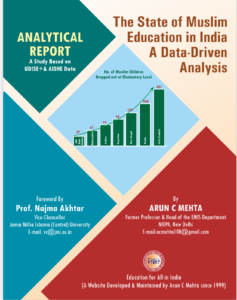Dose UDISE+ Underestimates Dropout Rates by Arun C Mehta
Dose UDISE+ Underestimates Dropout Rates?
By
Arun C Mehta
Formerly Professor & Head of the EMIS Department
NIEPA, New Delhi
Perhaps one of the most critical indicators through which the retaining capacity of the system is judged is the grade-to-grade dropout and average annual dropout rate. With the high dropout rates, a state or India as a whole cannot move towards universal school education which has a 100 percent GER by 2030 as has been envisaged in the National Education Policy 2020. The fate of planning exercises and their outcome can easily be understood if the official dropout rates disseminated through the UDISE+ do not accurately represent the system’s ability to retain children, which is also valid for transition and retention rates.
It may be recalled that UDISE was maintained by NIEPA from its inception in 1994-95 to 2017-18; thereafter, the same has been managed by the Department of School Education and Literacy of the Ministry of Education. It may be recalled that the entire Country got covered under the DISE in 2005-06 for the first time, and the same was extended to the entire school education sector in 2012-13; DISE since then is known as U-DISE or Unified DISE. All through the years 2005-06 to 2017-16, the flow rates, including average annual dropout rates, were continuously computed based on the common schools, and not all schools (including schools that were not covered in the previous year) were considered after that. If considered, all schools would underestimate the actual dropout rates or even present misleading and absurd rates, which has been demonstrated in the present note by taking accurate UDISE+ data of a state. The flow rates have been downloaded from the official portal of UDISE+; it is not mentioned whether the rates computed are based on all schools or common schools.
To know the retaining capacity of the system below, we analyze grade-to-grade dropout, transition, and completion rates in one of the states of India for the recent year, and the same is presented in Table 1. The table reveals that the state reported a ZERO dropout rate for the Cohort 2019-20 at the primary level, which is separately true for boys and girls. In 2017-18, the dropout rate at the primary level was 4.45 percent, which declined to 2.8 percent the following year.
It may be recalled that grade-specific enrolment for two consecutive years and grade-specific number of repeaters are required for the latest year to compute grade-to-grade dropout and average annual dropout rate. It is essential to consider common schools in both years; the newest year enrolment data might be based on more schools, as the schools not covered during the previous year are also covered in the current year. The UDISE+ data of the state demonstrated in this note shows that as many as 84,459 schools were covered in 2020-21, more than 3,184 new schools (3.53 percent) than covered during the previous year, which should not be considered in the dropout computation. As has already been explained above, if considered all schools are in computation, the dropout rate received is likely to underestimate the actual dropout rate.
| Table 1: Dropout Rate | |||||||||
| Cohort
|
Primary Level | Upper Primary Level | Secondary Level | ||||||
| Girls | Boys | Overall | Girls | Boys | Overall | Girls | Boys | Overall | |
| 2019-20 | 0.00 | 0.00 | 0.00 | 3.39 | 2.13 | 2.78 | 18.96 | 16.30 | 17.64 |
| 2018-19 | 1.52 | 3.01 | 2.28 | 9.24 | 8.61 | 8.93 | 22.66 | 20.01 | 21.36 |
| 2017-18 | 4.30 | 4.59 | 4.45 | 5.14 | 4.26 | 4.68 | 17.05 | 18.68 | 17.90 |
Source: UDISE, different years.
Dropout Rate based on all or Common Schools
The calculation of grade-specific flow rates based on 2019-20 and 2020-21 enrolment and 2020-21 repeaters are demonstrated in Table 2, which shows that the same is computed based on highly inconsistent data, which is primarily because of consideration of all schools instead of common schools. For example, the promotion rate in Grades 1, 2, 3, 4, 6, 9, and 10 is more than 100, which means that more students in these grades than in the previous Grade in the previous year because of this grade-to-grade dropout rate obtained in these grades is negative which is theoretical, not possible. Out of eight grades of elementary level, in six grades, the number of dropouts obtained is negative.
| Table 2
Grade-specific Enrolment & Repeaters: 2019-20 & 2020-21 |
|||||||||
| Classes | Enrolment | Number of | Flow Rates | ||||||
| 2019-20 | 2020-21 | Repeaters | Promotes | Dropouts | Repetition | Promotion | Dropout | Total | |
| I | 2551956 | 2708517 | 3212 | 2705305 | -338255 | 0.13 | 113.13 | -13.25 | 100 |
| II | 2564873 | 2890154 | 3155 | 2886999 | -249196 | 0.12 | 109.59 | -9.72 | 100 |
| III | 2461379 | 2814004 | 3090 | 2810914 | -155289 | 0.13 | 106.18 | -6.31 | 100 |
| IV | 2601198 | 2616369 | 2791 | 2613578 | -98046 | 0.11 | 103.66 | -3.77 | 100 |
| V | 2895787 | 2699239 | 2786 | 2696453 | 579201 | 0.10 | 79.90 | 20.00 | 100 |
| VI | 2271982 | 2316239 | 2439 | 2313800 | -82001 | 0.11 | 103.50 | -3.61 | 100 |
| VII | 2280794 | 2353924 | 2380 | 2351544 | -77293 | 0.10 | 103.28 | -3.39 | 100 |
| VIII | 2145742 | 2357853 | 2146 | 2355707 | 345088 | 0.10 | 83.82 | 16.08 | 100 |
| IX | 1618243 | 1800928 | 2420 | 1798508 | -99885 | 0.15 | 106.02 | -6.17 | 100 |
| X | 1606093 | 1719043 | 3335 | 1715708 | 668615 | 0.21 | 58.16 | 41.63 | 100 |
| XI | 880399 | 937311 | 3168 | 934143 | -52747 | 0.36 | 105.63 | -5.99 | 100 |
| XII | 797044 | 934363 | 4385 | 929978 | 792659 | 0.55 | – | – | – |
| Average Annual Dropout Rate
|
Primary Level
|
-2.00
|
Upper Primary
|
2.77
|
Secondary
|
17.64
|
|||
Source: Calculated based on UDISE 2019-20 & 2020-21 data.
Based on the above data, an attempt is made to compute the Average Annual Dropout Rate at primary, upper primary, and secondary levels of education (like UDISE+); in the case of the primary level of education, it comes out to be -2.00 which is reported ZERO by UDISE+ 2020-21. On the other hand, the dropout rate at upper primary and secondary levels comes out to be 2.77 and 17.64 percent, which is precisely reported in UDISE+ 2020-21.
| Table 3: Dropout Rate by Level of Education & Gender, Cohort 2019-20 | ||||||
| State /UT | Dropout Rate | |||||
| Primary Level: Grades 1 to 5 | Upper Primary Level: Grades 6-8 | |||||
| Boys | Girls | Total | Boys | Girls | Total | |
| Andaman and Nicobar Islands | 2.1 | 2.5 | 2.3 | 0.0 | 0.5 | 0.2 |
| Andhra Pradesh | 0.0 | 0.0 | 0.0 | 0.5 | 0.5 | 0.5 |
| Arunachal Pradesh | 9.8 | 6.8 | 8.3 | 8.3 | 7.0 | 7.7 |
| Assam | 4.2 | 2.3 | 3.3 | 6.0 | 3.2 | 4.6 |
| Bihar | 0.0 | 0.0 | 0.0 | 2.1 | 3.4 | 2.8 |
| Chandigarh | 0.0 | 0.0 | 0.0 | 0.0 | 0.0 | 0.0 |
| Chhattisgarh | 0.9 | 0.6 | 0.8 | 4.8 | 3.3 | 4.0 |
| Dadra & Nagar Haveli &
Daman and Diu |
4.1 | 3.1 | 3.6 | 0.0 | 0.0 | 0.0 |
| Delhi | 0.0 | 0.0 | 0.0 | 0.0 | 0.0 | 0.0 |
| Goa | 1.6 | 1.5 | 1.5 | 0.4 | 0.7 | 0.6 |
| Gujarat | 0.9 | 1.1 | 1.0 | 3.7 | 5.5 | 4.5 |
| Haryana | 2.2 | 2.1 | 2.1 | 0.0 | 0.0 | 0.0 |
| Himachal Pradesh | 1.9 | 1.9 | 1.9 | 1.4 | 1.3 | 1.3 |
| Jammu and Kashmir | 4.5 | 4.2 | 4.4 | 2.6 | 4.1 | 3.4 |
| Jharkhand | 4.1 | 2.9 | 3.5 | 5.1 | 5.4 | 5.2 |
| Karnataka | 1.3 | 0.9 | 1.1 | 2.0 | 1.9 | 2.0 |
| Kerala | 0.1 | 0.0 | 0.0 | 0.0 | 0.0 | 0.0 |
| Ladakh | 3.8 | 4.3 | 4.1 | 3.1 | 1.2 | 2.1 |
| Lakshadweep | 0.0 | 0.0 | 0.0 | 0.0 | 0.0 | 0.0 |
| Madhya Pradesh | 1.4 | 1.3 | 1.3 | 4.7 | 5.4 | 5.0 |
| Maharashtra | 1.1 | 0.9 | 1.0 | 1.2 | 1.6 | 1.4 |
| Manipur | 9.0 | 8.2 | 8.6 | 4.3 | 3.6 | 4.0 |
| Meghalaya | 8.7 | 6.1 | 7.4 | 10.2 | 7.7 | 8.9 |
| Mizoram | 8.5 | 7.6 | 8.1 | 7.0 | 3.4 | 5.2 |
| Nagaland | 6.6 | 5.2 | 5.9 | 4.8 | 2.8 | 3.8 |
| Odisha | 0.0 | 0.0 | 0.0 | 0.0 | 0.0 | 0.0 |
| Puducherry | 0.0 | 0.0 | 0.0 | 0.0 | 0.0 | 0.0 |
| Punjab | 0.0 | 0.0 | 0.0 | 0.0 | 0.0 | 0.0 |
| Rajasthan | 0.9 | 1.2 | 1.0 | 2.5 | 2.8 | 2.6 |
| Sikkim | 2.1 | 0.2 | 1.2 | 0.0 | 0.0 | 0.0 |
| Tamil Nadu | 0.7 | 0.5 | 0.6 | 0.6 | 0.6 | 0.6 |
| Telangana | 0.0 | 0.0 | 0.0 | 0.0 | 0.0 | 0.0 |
| Tripura | 4.5 | 3.8 | 4.2 | 3.8 | 2.8 | 3.3 |
| Uttar Pradesh | 2.3 | 2.1 | 2.2 | 2.6 | 6.5 | 4.5 |
| Uttarakhand | 1.8 | 1.7 | 1.7 | 1.3 | 1.6 | 1.4 |
| West Bengal | 0.0 | 0.0 | 0.0 | 0.0 | 0.0 | 0.0 |
| India | 0.8 | 0.7 | 0.8 | 1.6 | 2.3 | 1.9 |
| Source: UDISE+ 2020-21 | ||||||
As it seems, wherever the dropout rate is negative, the same in UIDSE+ is reported to be zero, which confines across all States & UTs of the Country; thus, not only the dropout but also the transition and retention rates across states do not present the accurate picture. In the case of 11 states at the primary and 12 states out of 37 States & UTs at the upper primary level, the UDISE+ 2020-21 reported an average annual dropout rate of ZERO, all of which is negative (see Table 3). For the states of Chandigarh, Delhi, Lakshadweep, Odisha, Puducherry, Punjab, and West Bengal, the UDISE+2020-21 reported a ZERO dropout rate both in the case of Boys and Girls, which is valid for primary as well as upper primary levels of education. With a high enrolment ratio and zero dropout rates, whether these states have achieved the goal of universal elementary enrollment is a moot question that the states and UDISE+ authorities must answer.
Since the dropout rates computed are based on all schools and not the common ones, the UDISE+ underestimate the actual average annual dropout rates. Similarly, eight states have reported a 100 percent transition rate from primary to upper primary and 12 states from upper primary to secondary level, all of which are above 100, which is also theoretically impossible.
Concluding Observations
From the UDISE+ Portal, it is impossible to download data based on common schools. The UIDSE+ authorities may like to switch over to the previous methodology adopted during 2005-06 to 2017-18 and, in the future, must compute and present flow rates based on common schools. In addition, they must re-compute the same during the years 2018-19 to 2020-21 and replace the same with the current rates so that the same can be used in the Annual Work Plan & Budget formulation under ongoing Samagra Shiksha Abhiyan as the current rates present the misleading picture. It is strange how targets on dropout, transition, and retention rates are currently being set out and how the implementing authorities monitor the progress of the same and take corrective measures. Or the UDISE+ authorities highlight the benefit of using all schools, if any, instead of common schools in computing dropout rates and must also explain how the current flow rates are comparable with the same before 2018-19.
Does UDISE+ Underestimates Dropout Rates by Arun C Mehta [Download PDF]
Trends in Dropout Rate at Elementary Level by Dr. ABL Srivastava



